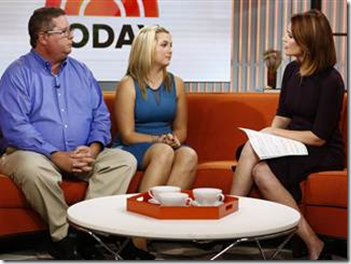I did not like this piece by Jessica Grose in The Daily Beast defending the toddler bikini. I don’t like it at all.
I’m not quite sure how I feel about toddler bikinis. Honestly, I think I agree with Grose on the issue for the most part, but I don’t like her argument one bit. It’s a mess.
Issues include:
Gwyneth Paltrow’s goofily named e-commerce website and blog, Goop, recently featured bikinis for girls 4 to 8 years old.
Don’t open the piece by making fun of the name of the website selling the bikinis. Even if you think Goop is a goofy name for a website (and I do not), it’s no way to begin an argument. Ad hominem attacks are unnecessary and undermine your authority.
Next:
“The British charity Kidscape, whose mission is to prevent bullying and child sexual abuse, took one look at the dour blonde child model donning the Odabash bikini on Goop and cried outrage.”
Also poorly argued. To imply that Kidscape “took one look” attempts to imply that the organization did not examine the issue closely before issuing their statement. Grose could not know this, and it is likely not true.
Also, using the phrase “cried outrage” implies that Kidscape’s statement was less than reasoned. Read the statement. Kidscape did not cry outrage. The organization released a statement that explained their opposition to these bikinis in clear, reasoned language, and I am quite sure this was written after more than just “one look.”
Next:
This isn’t the first time Kidscape has criticized a celebrity mom for her pro-bikini stance: They dissed Jessica Simpson back in September for putting her baby girl, Maxwell, in a yellow two-piece and showing pictures of the 4-month-old on Katie Couric’s show.
Dissed? Read their statement. Kidscape released a rationale statement expressing their concerns about these bathing suits, especially in light of Simpson’s celebrity status. They did not “dis” her. They did not attack her in any way. Once again, this is an attempt to imply an emotional response that simply did not exist.
Next:
“…if you unpack the logic behind it…”
This may be a personal preference, but “unpacking the logic” is a self- important phrase that carries no real meaning. You can examine the logic. Counter the logic. Debate the logic. Refute the logic. Oppose the logic. Even guffaw at the logic. But unpack the logic? Give me a break.
Next:
If you think there’s anything sexual about that child model’s presentation, you’re probably the kind of person who’s outraged by the retro Coppertone toddler. All that exposed cartoon flesh! The horror!
Not only does Grose make a broad assumption here (if you believe A, you must believe B), but she does not actually attempt to refute the opposition to the bikini or the retro Coppertone toddler. A sarcastic “All that exposed cartoon flesh! The horror!” is not an actual argument. There’s nothing wrong with a little sarcasm if it’s also supported with an actual reason or evidence, but Grose provides no reason whatsoever.
Next:
Beyond the misplaced fears of early sexualization, the other concern among the anti-bikini set is that girls who are put in bikinis at a young age will be more worried about their weight.
While I agree that these fears of early sexualization may be misplaced, Grose doesn’t actually make this argument. She simply dismisses them in this single transition sentence. “Beyond the misplaced fears of early sexualization?” When did we get beyond them?
Next:
But as Dr. Robyn Silverman tells the Today show, a mom’s attitude about body image is much more important for her daughter’s well-being than how much fabric her swimsuit has.
Agreed, but just because a mother’s attitude about body image trumps the amount of fabric in a toddler’s swimsuit does not mean that the swimsuit is irrelevant. No one is surprised that many factors play a role in a girl’s body issue, nor are we surprised that some factors might be more important than others. But to imply that the importance of one nullifies another entirely is an obvious a flaw in logic, packed or unpacked.
In addition to all of this, Grose cites expert’s appearances on The Today Show and a commenter on Jezebel in the piece, and other than a writer from the Daily Mail, these are the only sources she uses. I don’t think of any of these sources as serious or reliable. Basing your argument on the answers derived by third party journalists on a morning talk show is hardly the way to support your argument, and cherry-picking a random Jezebel commenter is convenient and ridiculous.
As I said, I ultimately agree with Grose on the issue of the toddler bikini. I don’t think I have a problem with it unless it is designed in poor taste.
But I have a problem with this piece.
While the bikini doesn’t offend my sensibilities, Grose’s argument does. It’s careless and at times ridiculous.

